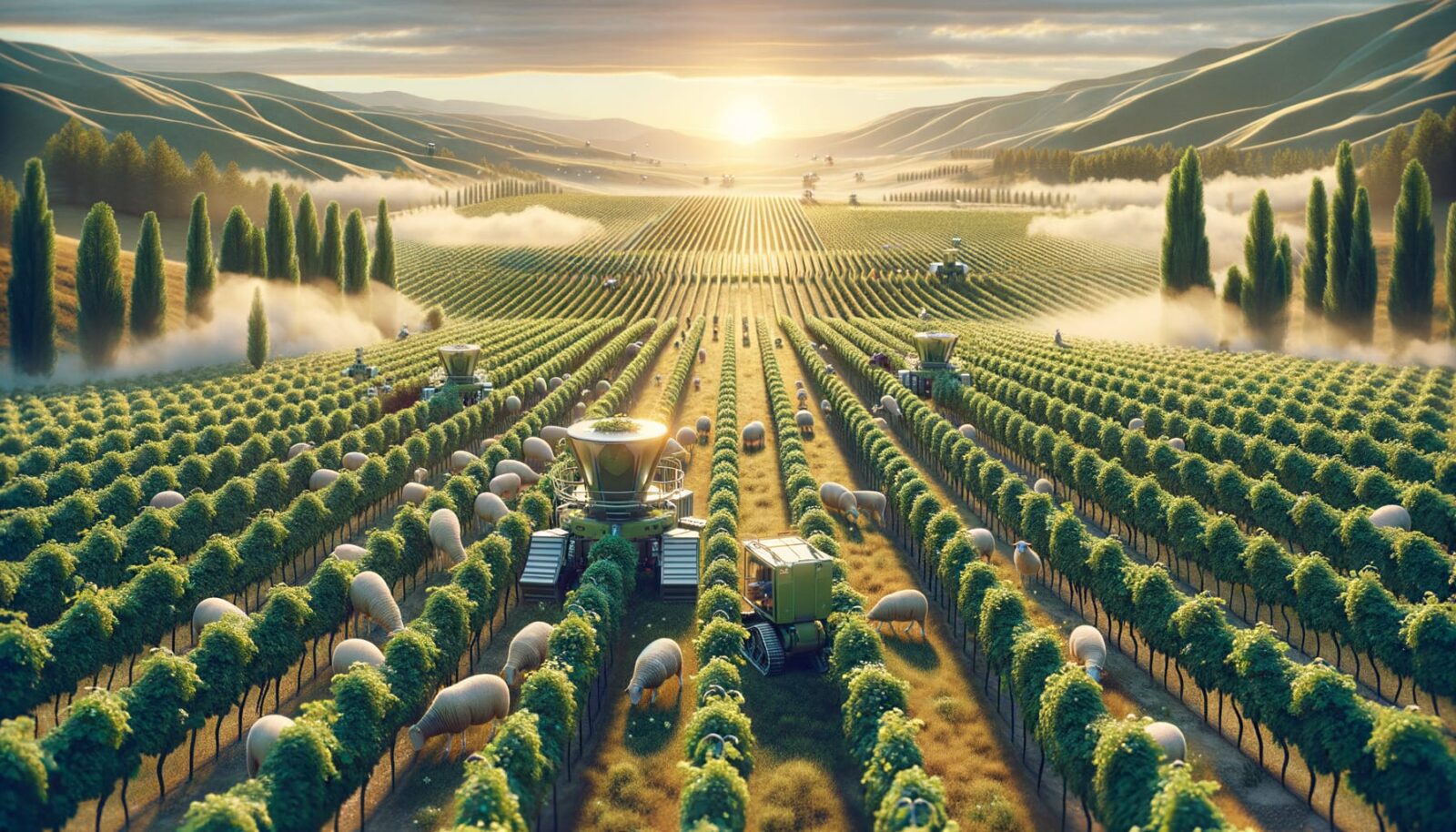Navigating a future of cross-sectoral forces
Download the full report for free
 NATIONAL CHALLENGES AND OPPORTUNITIES / Tuesday, 11 February 2025
NATIONAL CHALLENGES AND OPPORTUNITIES / Tuesday, 11 February 2025 

In the future, everything from global trade, marketing and input pricing to agronomic advice, production planning and security will be supported, enhanced or monitored by some form of artificial intelligence (AI). Technology will reshape Australian agriculture, with AI leading the way.
Already, AI-powered drones and sensors are monitoring crop health in real time, providing farmers with critical data to make informed decisions. This technology can also help in predicting weather patterns and pest outbreaks, allowing for proactive measures to protect crops. The AI revolution has the potential to make Australian agriculture more efficient and sustainable.
However, our rural industries are currently not well prepared to navigate a world where AI is ubiquitous. Work is required for producers to both trust the technology and have the skills to capture efficiency gains and develop increasingly valuable products.
For Australian agriculture, the impact of a changing climate will continue to exacerbate challenging climatic events including drought, floods and fires. Higher temperatures, prolonged dry spells and more regular extreme weather events will continue to test the sector’s resilience.
Rural industries will need strategies and technologies to maintain productivity while at the same time prioritising climate adaptation. At the farm level, this is already starting to happen.
“ |
Producers are beginning to baseline their emissions, but confusing systems and a lack of accessible information is hampering their efforts. In the future, they won’t have a choice. |
Markets, insurers and financial institutions will demand greater transparency about their environmental footprints. The message is clear: participate in disclosure systems or risk being left behind or cut out of key markets.
Australia is perceived as having a best-in-class biosecurity system, with our federal and state governments particularly adept at managing animal and plant diseases. Even so, the threat of a major pest or disease incursion will remain ever-present in coming decades as more intensive human, animal and wildlife interactions heighten the risk of a zoonotic or plant disease outbreak, or an invasive species incursion.
Strengthened detection systems, coupled with AI-driven biosecurity measures, will be critical in managing these risks, protecting the health of Australia’s agricultural ecosystems and maintaining export market access.
Our rural industries are well aware they could be more prepared for the increasing biosecurity threats. Preventative action – preparing for pest incursions before their first occurrence and taking a distinctly broader and more proactive approach – will be required to help Australia maintain its reputation as a global leader in biosecurity.
Australia’s agricultural exports are a cornerstone of the national economy, but global market conditions are shifting. Today, our rural industries are highly reliant on trade, following a decades-long growth trend, with most key trading partners in the Asia-Pacific region.
Though there remains considerable demand for both raw commodities and finished goods – agricultural exports are forecast to be worth $70.1 billion in 2024–2025 – conditions have become more precarious.
“ |
The rise of de-globalisation and geopolitical tensions is making traditional markets less predictable. |
Producers and industries are vulnerable to severe price fluctuations and market access regulations. Proactively seeking new markets and investing in domestic value-added processing are strategies to counter the uncertain international landscape. Seizing the opportunities presented by e-commerce and digital trade platforms is another.
By leveraging online marketplaces, producers in every corner of Australia can sell directly to consumers across the world, bypassing traditional intermediaries. Doing so can increase profit and provide greater control over pricing and branding.
In the coming 20 years, the incremental pressures Australian agriculture has long adapted to will become systemic shifts that will challenge the sector’s capability to respond. Producers have a proud history of both persevering in the face of climatic, trade and social licence pressures, and capitalising on opportunities from market development to technology adoption.
But as climate change increasingly influences what food we can produce and where, as new technologies allow for entirely new products and markets, and as social media-fuelled activism becomes more prevalent, the ‘way we’ve always done it’ will no longer be enough. The industry must embrace fundamental change to ensure its long-term sustainability.
What does that look like in practice? Prioritising enterprise resilience alongside enterprise productivity. Abandoning certain crops and adopting others in response to climate-influenced production constraints. Diversifying enterprise mixes to mitigate the substantial risk inherent in single-commodity production.
These systemic shifts provide an opportunity to evolve Australia’s research and development (R&D) system to better address the complexities of interconnected global and local forces.
As technology and sustainability reshape agriculture, societal expectations will also evolve. Consumers are increasingly demanding transparency, ethical practices and environmental stewardship. Meeting these expectations will require rural industries to meaningfully engage with communities and be transparent in their communication.
The movement of climate refugees – people voluntarily or involuntarily displaced by severe weather events – may also influence the Australian agricultural landscape: population shifts could create new demand for commodities in existing locations; but crop failures elsewhere will slash the global supply of affected commodities.
Rural industries will need to rethink how these migrations impact access to, and the affordability of, labour, onshore food demand, target market demographics and preferences, and competition for offshore labour (e.g. from the Pacific islands).
The next two decades hold immense potential for Australian agriculture. Yet the unprecedented and interconnected challenges on the horizon will demand new approaches, changed mentalities, transformed thinking.
“ |
The reimagined future will call into question what it means to be a ‘primary producer’ – the deep-rooted identity of the thousands who work on the land. |
The farmers of tomorrow will have skills the farmers of today don’t yet know they need.
The insights from the Navigating a future of cross-sectoral forces report underscore the importance of strategic planning and collaboration in ensuring a resilient and prosperous agriculture sector. Staying ahead of trends and proactively addressing challenges will be key. Likewise, diversification and innovation at the farm level is an important buttress against adverse events.
By building climate resilience, embracing technological advancements and fostering collaboration across industries, the sector can both navigate what lays ahead and thrive in an era where the only certainty is uncertainty.
Persistence has long been a hallmark of the Australians who produce food and fibre for the world. The coming decades will require that in no small dose. But they’ll also require change – and herein lies the challenge that Australian agriculture must rise to.
This article was originally published in the Australian Farm Institute’s Farm Policy Journal (Vol. 21, No. 4, 2024 – The next 20 years) and the original version is available on AFI’s website. It is republished here in full with express permission from AFI. Any reuse beyond personal use requires additional permission from the publisher.
Order the Farm Policy Journal (Vol. 21, No. 4) here
 HONEY BEE & POLLINATION / 11.02.25
HONEY BEE & POLLINATION / 11.02.25  WORKFORCE AND LEADERSHIP / 11.02.25
WORKFORCE AND LEADERSHIP / 11.02.25  CHICKEN MEAT / 11.02.25
CHICKEN MEAT / 11.02.25  WORKFORCE AND LEADERSHIP / 11.02.25
WORKFORCE AND LEADERSHIP / 11.02.25